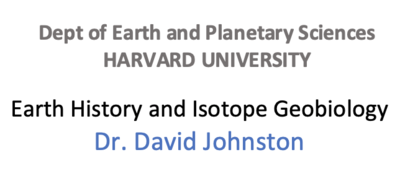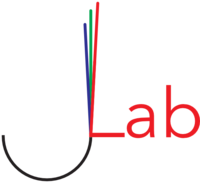What do sulfur isotopes reveal about the composition of the early atmosphere? Five undergraduates set out to explore this question as part of a short-term research project in the Johnston Lab this January. Over the course of three weeks, the students dug into geochemical data as a way to hone their statistical analysis and data visualization skills, and to get a taste for the kinds of questions and techniques involved in Earth science research.
First, here’s a brief overview of the connection between sulfur isotopes and the atmosphere of the ancient Earth. Terrestrial processes that involve sulfur typically produce compounds that have the sulfur isotopes 32S, 33S, 34S, and 36S in predictable ratios to one another. This occurs because these isotopes have slightly different masses, and they react differently according to those variations in mass; correspondingly, these processes and the isotopic signatures they produce are called “mass-dependent.”
But not all processes are mass-dependent. Farquhar et al. (2000) measured the sulfur isotopic compositions of sulfides and sulfates in deposits from the Archaean Eon (between 4 billion and 2.5 billion years ago) onward. They found that the sulfur isotopes in samples younger than about 2.09 billion years old followed those predictable ratios; that is, they were produced by mass-dependent processes. Samples between about 2.09 and 2.45 billion years old, however, showed small deviations from those patterns. And samples older than 2.45 billion years departed even more from the mass-dependent ratios. Those samples, the authors concluded, must have been formed through mass-independent processes.
These mass-independent signatures are widely considered to reflect the rise of oxygen in Earth’s atmosphere. The photochemical reaction in which UV light breaks down sulfur dioxide is mass-independent and could have produced the signatures that Farquhar et al. (2000) observed -- but this reaction can only happen to any significant extent when UV light can penetrate to the lower atmosphere. Ozone (O3) would have blocked that penetration, so a world with a lot of sulfur dioxide photolysis is likely also a world with very little ozone and molecular oxygen. In short, where mass-independent sulfur isotope signatures exist in the geologic record, oxygen was probably low; the disappearance of those signatures suggests that oxygen was becoming a major player in the atmosphere.
The students working on the project compiled the supplementary data from five papers, focusing on the Mount McRae Shale, a formation in western Australia that provides a geologic record of the period during which oxygen first started to accumulate in Earth’s atmosphere. Hosted by Dave Johnston and Haley Olson, the students -- three first-years (Aditya, Chase, and Anika) and two sophomores (Gorham and Raisha) -- used Python to visualize and run some statistical tests on the data they’d compiled, to see if any patterns stood out.
“It was my first exposure to pretty much everything we did -- Python programming (or any coding at all), exploratory data analysis, and Earth and Planetary Sciences,” Gorham told me, “so it was a fantastic learning experience.” He says that getting to work with a group was particularly helpful: “I appreciated the discussions we had along the way about our investigations.” Gorham also says he hopes to take some EPS classes in the future and is considering pursuing similar research.
The project in the Johnston Lab was part of a broader effort by the Earth and Planetary Sciences Department to provide undergraduates, particularly first-years and sophomores, with the opportunity to contribute to Earth science research, and to consider whether they might want to pursue this kind of research more formally. Some of the other projects included an investigation of the sunspot record and an exploration of seismic models.
Three weeks is a short time to dive into a completely new research project, but these students were up to the challenge. The Johnston Lab’s research into this area is ongoing and offers plenty of directions for inquiry, including into the potential links between the sulfur isotope record and other geochemical data. Regardless of the direction the research takes, it will have benefited from the work of these five students!
(Written by Maddie Goldberg)


